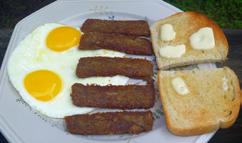
4 minute read
Top-10 Products from the Delaware Estuary
Symbol Alone
Logo with stacked type Top-10 Products from the Delaware Estuary
Advertisement
By Michelle Knoll, Outreach Programs Specialist, Partnership for the Delaware Estuary
Type Alone BASEBALL RUBBING MUD
Baseball is filled with traditions: the seventh inning stretch, dollar dog nights, rally caps, and rubbing mud on the baseball. Mud? Well not just any mud, but Delaware River mud! This mud that is from a secret place in New Jersey has been found to turn those new hardto-use, shiny baseballs into balls that are ready to use. This mud leaves no odor and doesn’t turn the balls black. So when you hear “Play ball!” remember that the Delaware River’s mud made this game possible. Discover more on YouTube at goo.gl/VCu6KE.
BEER
The world’s oldest consumed alcoholic beverage — beer — has only four ingredients, and the main one is water. Whether you’re a fan of porters, ales, or pilsners, approximately 90% of your pint is water. The Delaware Estuary has 119 breweries, 93 of which are craft breweries. Craft breweries recognize their dependence on clean water, and some support local watershed efforts as a result. For example, Victory’s Headwaters Pale Ale supports the environment with its Headwaters Grant. Saucony Creek brews a Stonefly IPA, of which 10% of sales support the protection of the Schuylkill River’s headwaters. And Flying Fish Brewing Company’s Exit Series beers feature ingredients local to New Jersey — like Delaware Bay oysters.
Credit: Tom Davidock
HORSESHOE CRABS
Blue blood and 10 eyes sounds like the description of a make-believe critter, but this describes the horseshoe crabs that live in the Delaware Bay! Their unique blue blood contains special cells called amebocytes, which protect these animals from the numerous bacteria found along shorelines. These cells attack pathogens by sealing them inside a gooey physical barrier. Today, researchers use this blood to test vaccines before human trials. If the blood releases goo then the product isn’t ready.
DIPPY EGGS AND SCRAPPLE
For breakfast, let’s have some “dippy eggs” and scrapple. Many eat eggs over-easy, so it’s easy to figure out what dippy eggs are. You dip your toast in them. But it’s a little harder to guess what scrapple is. Scrapple was first made in the 1800s near Philadelphia by German immigrants. These people did not want to waste any of their scraps left over after butchering their pigs, so they mixed scraps with flour, cornmeal, and spices and formed them into loaves before slicing and frying, making scrapple. These animals heavily rely on clean water to produce offspring; each chicken egg needs 53 gallons of water to produce it and keep the chicken healthy.


BANANAS

The Philadelphia Exposition in 1876 was one of the first opportunities for people living in the Estuary to try an exotic yellow fruit. Bananas were first served at the time with a knife and fork and came wrapped in tinfoil. Today Americans eat more than 28 pounds of bananas per person each year. And many of these bananas are imported through the Port of Wilmington, as it is the largest import port for fresh bananas in the country.
SLINKY
Some of the best things happen by mistake. While working on the Cramp Shipyard along the Delaware River, Richard James was attempting to create a spring that would keep important equipment shipboard while on the high seas. One day a rejected coil fell on the floor and the idea for the Slinky was born! For two more years, he worked on the metal and proportions before he made the first Slinkys to sell. They sold out in 90 minutes when they were first displayed at Gimbels in November of 1945.
CRAYONS
According to Yale University, the most recognized smells to adults are peanut butter and coffee. Number 18 on that list is Crayola Crayons. These crayons have been made since 1903 in Easton, Pennsylvania. The most popular color of Crayola crayon is blue. The company also makes paints, glues, and markers. To make all of their products the company uses 18 million gallons of water a year.
Credit: Pixabay.com
MUSHROOMS
Southwest of Philadelphia in the small town of Kennett Square the air is smelly and the mushrooms are growing. This area produces almost half of U.S. mushrooms — that’s over 400 million pounds of mushrooms per year. Mushrooms are a super food as they have little fat, sugar or salt and they do contain many essential minerals, such as potassium, copper and iron. Mushrooms are even more than 90% water! n

CAVIAR
It’s the mid-1800s and you are sitting at a restaurant or bar in New Jersey, so instead of peanuts to go with your beer you are given free caviar. These salted Atlantic sturgeon eggs were abundant at the time, because the Estuary was the top exporter in the world! They were so abundant that it was common in local eating establishments. Unfortunately, due to overharvesting, the caviar business crashed in the early 1900s and today the population of sturgeons is endangered in the Delaware Bay.
SOUP
“So Many Many Reasons It’s So Mmm Mmm Good”; that’s Campbell’s Soup of course. This company in 1897 was the first to cook and can condensed soup in America. The company is still based in Camden and continues to make the soup that we all love so much using resources from the Delaware Estuary.







